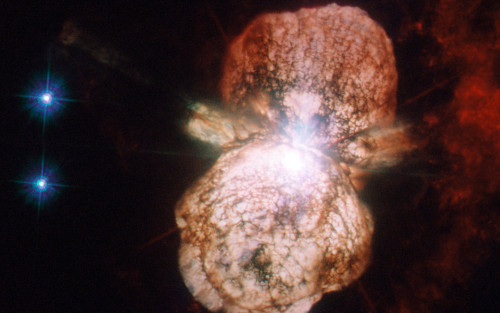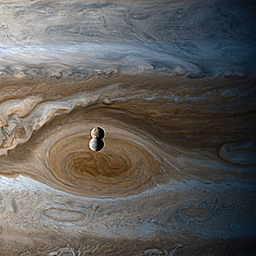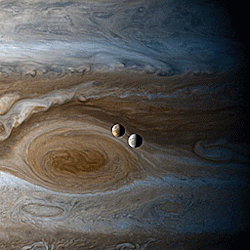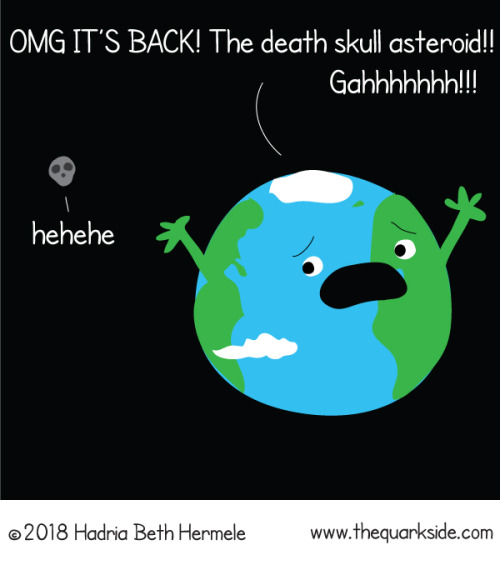This Fibonacci Joke Is As Bad As The Last Two You Heard Combined
this fibonacci joke is as bad as the last two you heard combined
More Posts from Science-is-magical and Others

Feb 28, 2013 - By wearing different colored hats, over 2,600 employees at Genentech (in San Francisco) celebrated the 60th anniversary of the discovery of DNA
The Brain Can Reveal Drinking Status Even After Death
Scientists who use postmortem brain tissue to study alcohol’s effects on brain structure and function will find this research interesting. Phosphatidylethanol (PEth) is an alcohol metabolite and its concentration in whole blood samples is a biomarker of drinking habits. For this study, scientists examined PEth levels in postmortem brains of individuals known to have had alcohol use disorders (AUDs).
Researchers divided 30 postmortem brains into three groups: 10 with AUDs that had positive serum alcohol levels present at the time of autopsy; 10 with AUDs that did not show positive serum alcohol levels at the time of autopsy; and 10 normal brains. PEth levels were measured in the cerebellum and orbital frontal cortex (OFC) regions.
Results showed that PEth was present in the cerebellum and OFC of all brains in all three groups of subjects, including the controls. The AUD group with detectable serum alcohol levels at the time of autopsy had much higher levels of PEth in both brain areas than either the control group or the AUD group whose subjects did not have detectable serum ethanol at autopsy. Thus, the ability to measure PEth levels in postmortem human brains can be helpful in classifying drinking status in individuals with AUDs at the time of death.

There’s Evidence of a New Ninth Planet. For real!
Caltech researchers have found evidence of a giant planet tracing a bizarre, highly elongated orbit in the outer solar system. The object, nicknamed Planet Nine, has a mass about 10 times that of Earth and orbits about 20 times farther from the sun on average than does Neptune, farthest planet from the Sun. In fact, it would take this new planet between 10,000 and 20,000 years to make just one full orbit around the sun.
Planetary scientists, Konstantin Batygin and Mike Brown, describe their work in the current issue of the Astronomical Journal and show how Planet Nine helps explain a number of mysterious features of the field of icy objects and debris beyond Neptune known as the Kuiper Belt.
Unlike the class of smaller objects now known as dwarf planets, Planet Nine gravitationally dominates its neighborhood of the solar system. In fact, it dominates a region larger than any of the other known planets.
Batygin and Brown predicted the planet’s existence through mathematical modeling and computer simulations but have not yet observed the object directly.
To put it briefly, Batygin and Brown inferred its presence from the peculiar clustering of six previously known objects that orbit beyond Neptune. They say there’s only a 0.007% chance that the clustering could be a coincidence. Instead, they say, a planet has shepherded the six objects into their strange elliptical orbits, tilted out of the plane of the solar system. It wasn’t the first possibility they investigated and they ran different simulations until finding that an anti-aligned orbit of the ninth planet prevents the Kuiper Belt objects from colliding with it and keeps them aligned. read more here
Diagram: The six most distant known objects in the solar system with orbits beyond Neptune (magenta) all mysteriously line up in a single direction. Also, when viewed in three dimensions, they all tilt nearly identically away from the plane of the solar system. A planet with in a distant eccentric orbit anti-aligned with the other six objects (orange) is required to maintain this configuration. The diagram was created using WorldWide Telescope. Credit: Caltech/R. Hurt (IPAC)

Oh hey, not a big deal, but the hubble took a picture of a star that’s nearing supernova status


Timelapse of Europa & Io orbiting Jupiter, shot from Cassini during its flyby of Jupiter

Machine Learning: An In-Depth, Non-Technical Guide
A good introductory text in five parts:
Overview, goals, learning types, and algorithms
Data selection, preparation, and modeling
Model evaluation, validation, complexity, and improvement
Model performance and error analysis
Unsupervised learning, related fields, and machine learning in practice
By Alex Castrounis - {InnoArchiTech}




On Oct 31, 2015 scientists used radar imaging to photograph a little dead comet. Much to their surprise, it looked quite a lot like a skull! Due to that and the timing, they nicknamed it Death Comet.
Death Comet will swing by us again this year (albeit a little later than last time).
You can read more about the Death Comet here: https://www.universetoday.com/140108/the-death-comet-will-pass-by-earth-just-after-halloween/
Happy Halloween, all!!! 💀🎃

A Powerful Solar Flare : It was one of the most powerful solar flares in recorded history. Occurring in 2003 and seen across the electromagnetic spectrum, the Sun briefly became over 100 times brighter in X-rays than normal. The day after this tremendous X 17 solar flare – and subsequent Coronal Mass Ejection (CME) – energetic particles emitted from the explosions struck the Earth, creating auroras and affecting satellites. The spacecraft that took these frames – SOHO – was put in a turtle-like safe mode to avoid further damage from this and subsequent solar particle storms. The featured time-lapse movie condenses into 10 seconds events that occurred over 4 hours. The CME, visible around the central sun-shade, appears about three-quarters of the way through the video, while frames toward the very end are progressively noisier as protons from the explosions strike SOHO’s LASCO detector. One this day in 1859, the effects of an even more powerful solar storm caused telegraphs on Earth to spark in what is known as the Carrington Event. Powerful solar storms such as these may create beautiful aurora-filled skies, but they also pose a real danger as they can damage satellites and even power grids across the Earth. via NASA
-
 pxlpanic reblogged this · 1 week ago
pxlpanic reblogged this · 1 week ago -
 mysticthemulticolouredmew liked this · 2 weeks ago
mysticthemulticolouredmew liked this · 2 weeks ago -
 cherrytree-irl reblogged this · 2 weeks ago
cherrytree-irl reblogged this · 2 weeks ago -
 namesarehardforme reblogged this · 2 weeks ago
namesarehardforme reblogged this · 2 weeks ago -
 adfredffr liked this · 2 weeks ago
adfredffr liked this · 2 weeks ago -
 freelathed reblogged this · 2 weeks ago
freelathed reblogged this · 2 weeks ago -
 karmatone liked this · 2 weeks ago
karmatone liked this · 2 weeks ago -
 friend-through-teenage-nights reblogged this · 2 weeks ago
friend-through-teenage-nights reblogged this · 2 weeks ago -
 grimdarkfandango reblogged this · 2 weeks ago
grimdarkfandango reblogged this · 2 weeks ago -
 undigestedbeef liked this · 2 weeks ago
undigestedbeef liked this · 2 weeks ago -
 sunny-daze-cosplay reblogged this · 2 weeks ago
sunny-daze-cosplay reblogged this · 2 weeks ago -
 le-trash-prince liked this · 2 weeks ago
le-trash-prince liked this · 2 weeks ago -
 oldsargasso reblogged this · 2 weeks ago
oldsargasso reblogged this · 2 weeks ago -
 goofy-guy-dj liked this · 2 weeks ago
goofy-guy-dj liked this · 2 weeks ago -
 astervibing reblogged this · 2 weeks ago
astervibing reblogged this · 2 weeks ago -
 a-cipher reblogged this · 2 weeks ago
a-cipher reblogged this · 2 weeks ago -
 foul-cupcake liked this · 2 weeks ago
foul-cupcake liked this · 2 weeks ago -
 coffeeboybro liked this · 3 weeks ago
coffeeboybro liked this · 3 weeks ago -
 levaminos reblogged this · 3 weeks ago
levaminos reblogged this · 3 weeks ago -
 nevillesaynever liked this · 3 weeks ago
nevillesaynever liked this · 3 weeks ago -
 steampaul reblogged this · 3 weeks ago
steampaul reblogged this · 3 weeks ago -
 steampaul liked this · 3 weeks ago
steampaul liked this · 3 weeks ago -
 the-frog-wizard-fe reblogged this · 3 weeks ago
the-frog-wizard-fe reblogged this · 3 weeks ago -
 evil-wild-lesbian-wizard reblogged this · 3 weeks ago
evil-wild-lesbian-wizard reblogged this · 3 weeks ago -
 evil-wild-lesbian-wizard liked this · 3 weeks ago
evil-wild-lesbian-wizard liked this · 3 weeks ago -
 puppypolymathy reblogged this · 3 weeks ago
puppypolymathy reblogged this · 3 weeks ago -
 puppypolymathy reblogged this · 3 weeks ago
puppypolymathy reblogged this · 3 weeks ago -
 puppypolymathy reblogged this · 3 weeks ago
puppypolymathy reblogged this · 3 weeks ago -
 puppypolymathy liked this · 3 weeks ago
puppypolymathy liked this · 3 weeks ago -
 sauleline2 reblogged this · 3 weeks ago
sauleline2 reblogged this · 3 weeks ago -
 jojolimons reblogged this · 3 weeks ago
jojolimons reblogged this · 3 weeks ago -
 belannaswlonkderfulworm reblogged this · 3 weeks ago
belannaswlonkderfulworm reblogged this · 3 weeks ago -
 belannaswlonkderfulworm liked this · 3 weeks ago
belannaswlonkderfulworm liked this · 3 weeks ago -
 imoanurparentsnames reblogged this · 3 weeks ago
imoanurparentsnames reblogged this · 3 weeks ago -
 themontess reblogged this · 3 weeks ago
themontess reblogged this · 3 weeks ago -
 hexblade liked this · 3 weeks ago
hexblade liked this · 3 weeks ago -
 dragonessmiralis reblogged this · 3 weeks ago
dragonessmiralis reblogged this · 3 weeks ago -
 dragonessmiralis liked this · 3 weeks ago
dragonessmiralis liked this · 3 weeks ago -
 gooopy reblogged this · 3 weeks ago
gooopy reblogged this · 3 weeks ago -
 gooopy liked this · 3 weeks ago
gooopy liked this · 3 weeks ago -
 jastertown reblogged this · 3 weeks ago
jastertown reblogged this · 3 weeks ago -
 exit-pursued-by-a-lesbian reblogged this · 3 weeks ago
exit-pursued-by-a-lesbian reblogged this · 3 weeks ago -
 exit-pursued-by-a-lesbian liked this · 3 weeks ago
exit-pursued-by-a-lesbian liked this · 3 weeks ago -
 platiepuz reblogged this · 3 weeks ago
platiepuz reblogged this · 3 weeks ago -
 crayonmilkz liked this · 3 weeks ago
crayonmilkz liked this · 3 weeks ago -
 loudandclearnow reblogged this · 3 weeks ago
loudandclearnow reblogged this · 3 weeks ago -
 listlesswhistle reblogged this · 3 weeks ago
listlesswhistle reblogged this · 3 weeks ago -
 cursedberrycompote reblogged this · 3 weeks ago
cursedberrycompote reblogged this · 3 weeks ago -
 hajvaffla reblogged this · 3 weeks ago
hajvaffla reblogged this · 3 weeks ago -
 hajvaffla liked this · 3 weeks ago
hajvaffla liked this · 3 weeks ago
